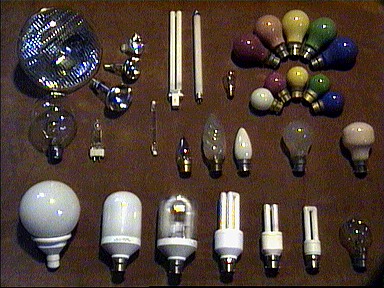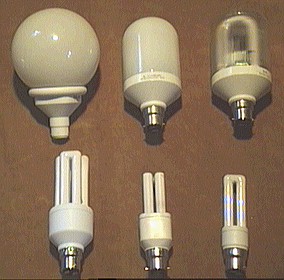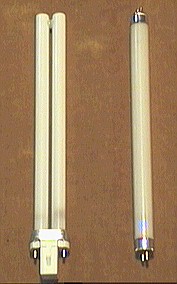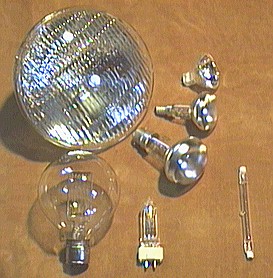 @Lighting Workshop.com
@Lighting Workshop.com @Lighting Workshop.com @Lighting Workshop.com |
| Lighting Workshop Home Domestic Lamps Discharge Lamps High Power Lamps Special Lamps How Lamps Work |
Lamps
Lamps are the most important part of any lighting scheme. To the right is a small selection (32) of lamps that is intended to represent the many thousands of different lamps on the market. Lamps power ranges from 5W energy saving lamps to halogen lamps that use 650W and above. The exact lamp power and type is dependent on the fitting chosen, area to be lit and the required luminance. GLS/Golf-ball Lamps The GLS (General Lighting Service) lamp is the standard lamp or "bulb" used for most domestic fittings. These lamps are available from the mere glow of an 8W nightlight lamp up to a dazzling 500W and can have various finishes such as clear, pearl, coloured and pastel tints. Clear lamps are ideal for glass fittings because they produce a harsh light that can make the fitting sparkle as the light reflects and refracts through the glass. Pearl finish lamps produce a softer, more diffused light that is better for direct lighting e.g. pendent fittings, table lamps etc. Coloured lamps are generally used outside only. They are available in golf-ball and GLS sizes and 15, 20, 25 and 60W. It is important that lamps above 25W are protected from moisture (e.g. rain) as the sudden cooling caused by the water can cause the glass envelope to shatter. The light from GLS lamps tends to be slightly yellow, giving it a warm, cosy feel. Variations on the GLS lamp include pigmy and candle lamps. Pigmy lamps are ideal for lighting small spaces such as refrigerators, cupboards and display cabinets. Candle lamps are a more attractive shape than GLS lamps so can be used where the lamp is visible. There are many types of candle lamp including two sizes of twisted lamp, plane candle, clear, pearl and flickering. Flickering candle lamps emit a dim neon glow that dances up and down inside the lamp. If you have found a use for flickering candle lamps, please let me know!

Energy Saving Lamps To the left is a selection of the ever-increasing range of energy saving lamps. The conventional energy saving lamp is a fluorescent tube and control gear [see fluorescent lamps] squeezed into one package that can replace a GLS lamp. Recently the conventional control gear has been replaced with electronics that offers a saving in weight and power consumption. These lamps are available with a round globe [top left], diffused [top middle], prismatic [top right] and without a diffuser [bottom]. The latest development in fluorescent lamp technology means you can now buy energy saving lamps with pastel tones e.g. peach, pink... Although these lamps have a warm light, the characteristics of the light is not the same as a GLS lamp but is quite acceptable for most domestic applications. However it should be noted that these lamps cannot currently be used with a dimmer switch but this might change in the future.

Fluorescent Lamps Fluorescent lamps lie under the heading of discharge lamps. They consist of a hollow tube, coated with a fluorescent phosphor and filled with mercury vapour/argon mixture. In either end are electrodes that provide the energy for the light to work. These lamps require control gear that comprises a ballast and starter switch in order to work. This type of lamp uses about 80% less electricity than GLS lamps and lasts 5 times longer. There are many variations on the basic fluorescent lamp including "Energy Saving lamps", single ended fluorescent, and sizes from 6 inches to 8 feet long. Most tubes are available in various colours from the cold "North Light" to "White" and "Warm White". Although "Warm White" tubes are available, the light tends to be harsh and have a clinical, unnatural appearance. Typically double-ended fluorescent lamps are used where a bright light is required and the aesthetics of the fitting is unimportant. This tends to be applications such as garage lighting, supermarkets, offices and under-cabinet lighting. Fluorescent lamps can be dimmed provided the control gear is designed for dimming and the dimmer is designed for fluorescent loads. Most fluorescent fittings and dimmers available in the high street or DIY superstores are not suitable for this type of application so it is best to seek expert advice. 
Reflector and Halogen Lamps Reflector lamps have an internal reflector that is designed to project the light in one direction. This means it is possible to direct the light to where it is required rather than "flooding" the room with light. There are three main types of reflector lamp; R class, PAR and low voltage. Reflector (R class) lamps are a modified GLS lamp with a silvered band (reflector) just above the neck. These are the cheapest type of reflector lamp and have a wide soft beam. PAR (Parabolic Aluminised Reflector) lamps are moulded from thick glass and some are suitable for use outside as garden spotlights. They come in a variety of beam sizes, determined by the design of the front of the lamp, which can be Spot, Flood or Wide Flood. Low voltage lamps are usually halogen [see below] and again these can be sub divided into PAR, Aluminium and Dichroic reflector lamps. The low voltage PAR lamps are identical to those described above except they run on 6 or 12V supply. Aluminium reflector lamps have an aluminium reflector with a small, low voltage, halogen capsule lamp mounted in the centre. Dichroic lamps take there name from the special reflective coating. The reflector is moulded glass with a dichroic coating that reflects visible light out the front of the lamp but allows heat to escape through the glass into the fitting. These are the most efficient type of reflector lamp. Halogen lamps have get their name from the group of elements (the Halogens) used in this type of lamp. As a lamp heats up the tungsten filament begins to vaporise which would normally be condensed onto the glass. In a halogen lamp the halogen condenses the tungsten back onto the filament thus extending the lamp life and permitting the filament to run at higher, more efficient, temperature. Along with higher efficiency halogen lamps are also smaller than conventional lamps [Bottom Left: Conventional 500W lamp. Bottom Centre: Halogen equivalent.]. These lamps give a bright, crisp, white light and last twice as long as GLS lamps. It should be noted that halogen lamps can be dimmed however this may reduce the lamp life as the halogen does not work as effectively at lower temperatures. These lamps produce large amounts of heat which, as with all lamps, must be considered when locating light fittings. Halogen lamps must not be handled with your fingers as any dirt or grease on the lamp may cause it to melt or crack with disastrous results. [Back] |
 |
| © 2006 |